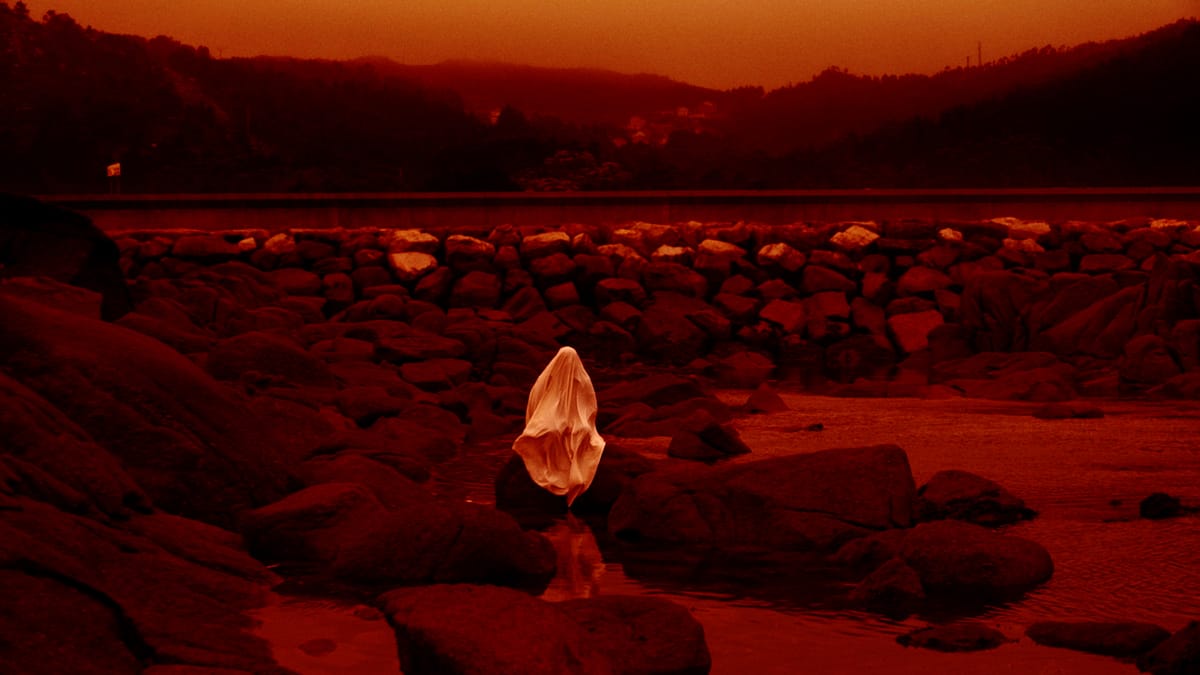Red Moon Tide ★★★☆☆

Red Moon Tide is the latest feature by Galician director, screenwriter, and cinematographer Lois Patiño. A much-loved member of a rural fishing community has gone missing, and ever since his disappearance an immobilising curse has worked its way into each of the villagers.[Red Moon Tide is streaming on MUBI now.]
The film begins as night descends upon a small fishing village 50 miles north of nowhere. For a few moments we amble around the empty landscape. The sky is dark and cloudless — a swirling mass of grey and deep purple. A river winds its way towards a blurred horizon, shimmering occasionally under the silvery light of the rising moon. The shores are a mixture of boggy wetlands and rocks the colour of desert sands, green and weathered at their edges. We see some of the locals, both up-close and at a distance; they each stare at the floor, unmoving, their faces hard and sombre. They sit outside their homes and stand at the sides of roads, and after a while it becomes clear why they’re all so silent: they can’t move.
Over the course of the first half an hour, through gravelly, inflectionless narrations, we begin to understand the cause of this strange collective behaviour. We are told that a man by the name of Rubio is missing, presumed drowned. Some believe that his boat hit upon some rocks and the rest was taken care of by the tide, others believe there’s a beast that lurks in the water, and, having taken care of one of their strongest, is now coming for them all. It is during this time that the film establishes its supernatural setting. The evil spirit appears to draw its power from the moon, and this power, as we come to learn, is ubiquitous. We see shot after shot of vacant lots and abandoned mines, untrodden marshes and echoey caverns — and not a single sign of life remains. Apart from the breaking of the waves on the rocks and the howl of the wind, the only sound we hear is the distant squelch of the dead man’s boot stalking us as we make our rounds.
I thought this opening sequence was the most successful and enjoyable part of Red Moon Tide; it was fresh and exciting, earnest where it needed to be, and brimming with detail and new ideas; as a contribution to the tradition of slow cinema, it slotted in quite seamlessly. Much of the substance — and nigh-on poetry — of these opening moments is due to the exquisite cinematography that Patiño presides over. The aesthetic as a whole pays, of course, an enormous debt to the work of Andrei Tarkovsky, but in the details where others before him chose to make cheap copies, Patiño has chosen to reinvent. From the beguiling shots of reeds oscillating casually, to the tracking shots of the trees at dusk, Patiño demonstrates a remarkable astuteness for what made films like Solaris (1972) and Mirror (1975) able to wrap the real world in a veil of such unearthly grace.
in the details where others before him chose to make cheap copies, Patiño has chosen to reinvent
After showing us the extent of the town’s sudden hypnotic paralysis, Patiño lets the narrative unfold — which is to say, lets it fall apart. Little effort is put into explaining why the coven of witches arrives in the village — except for a three-line intertitle which ends with the line “Nobody knew where they came from”, and even less effort is put into explaining why they go round draping white sheets over each of the villagers for thirty minutes. This, as well as the frequent allusions to shipwrecked boats and beasts of the deep, should have been the clunk! that let me know that the wheels of the cart were about to come flying off. With each hint that the immobilising force was something material, something physical, Patiño slowly cleared the fog and mystery he so carefully crafted, and neutralised the venom of his film’s suspense.
And what a kick in the teeth that final sequence was. What we presume to be beyond touch, beyond sight, and beyond comprehension, is in fact a big fish with red lights on it. And with this revelation, all our theorising — perhaps that the beast was really an abstraction for the exploitation of the resources of small communities — is revealed to be a senseless exercise. Patiño leads us to believe that the villagers need something supernatural, something abstract, and yet it is revealed to us that all they needed was half a dozen barrels, a handful of slugs and a shotgun, and Roy Scheider at the helm of an orca. So who wins here? Those who believe or want it to be a real sea monster will be driven to the limits of tedium by the first hour, while those who engage with the abstractions and poetry will feel betrayed by the film’s laughably ‘duh!’ ending. It is as though the Royal Philharmonic had decided that after an evening of Sibelius and Brahms, for their encore they’ll play some Motörhead. Now maybe there is a link between Damage Case and Finlandia — in any case, I couldn’t find it.
The best comparison I can make is to Werckmeister Harmonies (2000). Imagine if at the end of Werckmeister it was revealed that there was no ambiguity within the fiction, and that the riots had occurred only because the rotting whale’s toxic odour had lulled the townsfolk into some kind of hallucinatory rage. This would rather ruin the poetry of the first two hours, wouldn’t it? Sometimes it’s best if a cigar is not just a cigar.








